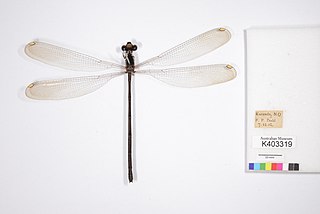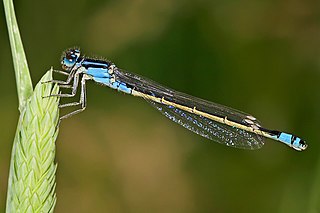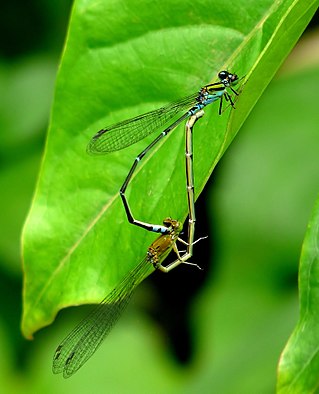
Coenagrionidae or are a family of damselflies, also known as pond damselfies, in the order Odonata and the suborder Zygoptera. The Zygoptera are the damselflies, which although less known than the dragonflies, are no less common. More than 1,300 species are in this family, making it the largest damselfly family. The family Coenagrionidae has six subfamilies: Agriocnemidinae, Argiinae, Coenagrioninae, Ischnurinae, Leptobasinae, and Pseudagrioninae.

Podopteryx is a damselfly genus. It belongs in the family Argiolestidae. They are very large damselflies found in Indonesia, New Guinea and Australia.

The Platycnemididae are a family of damselflies. They are known commonly as white-legged damselflies. There are over 400 species native to the Old World. The family is divided into several subfamilies.

Agriocnemis is a genus of damselfly in the family Coenagrionidae. Agriocnemis is distributed widely across Africa, South-east Asia, Indonesia, Australia and islands in the Pacific. They are small insects, commonly known as wisps.

Anaciaeschna is a genus of dragonflies in the family Aeshnidae. Species of Anaciaeschna are found in Africa, Asia and Australia.

Argiocnemis is a genus of damselfly in the family Coenagrionidae. Species of Argiocnemis are generally small to medium-sized damselflies, darkly coloured with pale markings. They occur in Africa, Indian Ocean islands, South-east Asia, New Guinea and Australia.

Ceriagrion is a genus of damselfly in the family Coenagrionidae. Species of Ceriagrion are small to medium size, generally brightly coloured damselflies. They are found across the Old World, Africa, Asia and Australia.

Indolestes is a genus of damselflies in the family Lestidae. Species of Indolestes can be medium-sized, dull coloured dragonflies. They are found from India through Asia, Australia and the Pacific.

Ischnura is a genus of damselflies known as forktails in the family Coenagrionidae. Forktails are distributed worldwide, including various oceanic islands. The males have a forked projection at the tip of the abdomen which gives the group their common name.

Pseudagrion is the largest genus of damselfly in the family Coenagrionidae, with over 140 species. Its range includes most of Africa, much of Asia, and Australia. Africa holds most of the diversity with almost 100 species. It has occupied most of the freshwater habitats in its range, and dominates damselfly communities in habitats as different as desert pools, equatorial rainforests and montane streams.

Teinobasis is a genus of damselflies in the family Coenagrionidae. Species occur in south-eastern Asia, Indonesia, Solomon Islands and Micronesia; one species, Teinobasis rufithorax, is found in Australia.

Tetrathemis is a genus of dragonflies in the family Libellulidae. Species of Tetrathemis are found in Africa, Madagascar, Asia, New Guinea and Australia.

Tramea is a genus of dragonflies in the family Libellulidae, the skimmers and perchers. Species of Tramea are found in tropical and subtropical regions around the globe. They typically have colored bases to their otherwise translucent hindwings. In particular when they fly, this creates the impression of their carrying bags at the start of their abdomens. They are known commonly as saddlebags or saddlebags gliders.

Rhadinosticta is a genus of damselfly in the family Isostictidae, endemic to eastern Australia. Species of Rhadinosticta are slender, medium-sized damselflies, with a dull colouring.

Nannophlebia is a genus of dragonfly in the family Libellulidae. They are commonly known as Archtails. The species are very small with black and yellow striped abdomens.
Huonia is a genus of dragonfly in the family Libellulidae. Species of this genus are found in Indonesia, New Guinea and Australia.

Austroagrion is a genus of damselflies belonging to the family Coenagrionidae. Species of Austroagrion are small damselflies; males are black with blue or green markings while females are paler. Austroagrion occurs in Papua New Guinea, New Caledonia and Australia.

Chorismagrion is a monotypic genus of damselflies belonging to the family Synlestidae. The single species of this genus, Chorismagrion risi, known as a pretty relict, is a slender, medium-sized damselfly, mostly black in colour with white markings. It is endemic to north-eastern Australia, where it inhabits streams and large pools in rainforests.

Archibasis mimetes is a species of damselfly in the family Coenagrionidae, commonly known as a blue-banded longtail. It is a medium-sized damselfly; the male is bright blue and black. It has been recorded from New Guinea and northern Australia, where it inhabits streams.
Rhadinosticta handschini is a species of damselfly in the family Isostictidae. It has been reported from northern Australia, where it inhabits streams. Rhadinosticta handschini is a slender, medium-sized, dully-coloured damselfly.



















